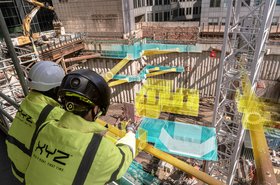The growing demand for data centers has never been so urgent. Rapidly advancing technologies like machine learning, AI, and quantum computing, data’s exponential rise, under-pressure vacancy rates, and widespread digitization are all driving an insatiable hunger for storage and processing power.
These ever-increasing volumes of data need housing somewhere and this means acres of space, serious amounts of energy, and larger and larger data campuses, especially at the hyperscale end of the market.
Naturally, the data itself isn’t only creating demand for this infrastructure; it’s also impacting how these facilities are built. Data center construction is lengthy, complex, prone to severe delays, and drains capital budgets.
You can see this impact from the recent earnings calls of the world’s largest technology companies. Data centers in some way or another all featured in recent investor statements. Amazon alone has earmarked $150 billion to meet AI demand, for example. The company isn’t alone.
On-time delivery is everything
Such is the complexity and density of facilities nowadays, it’s unsurprising that these builds are often plagued by errors—from various sources—that cause projects to slip out of schedule and prompt time-consuming rework.
This, in turn, racks up significant costs stretching into the millions of dollars, delays time to market, and produces a lot of waste that impacts a project’s sustainability credentials.
There is a critical demand from those behind such mammoth projects to increase their project efficiency, accuracy, cost consciousness, and time to revenue.
If you’ve ever worked in data center construction like I have, you’ll know the frustration of knocking down something you’ve just built because it was installed incorrectly or seeing the effects of poor visibility, sluggish project planning or murky scheduling.
When the clock is ticking and the dollars are racking up, speed and accuracy are everything.
Construction data utility
The solution for ill-managed data center construction? Perhaps ironically: data.
Put simply, real-time data from the field transforms a project fueled by guesswork into an objective, accurate, and efficient program.
Better yet, collecting, funneling, and reporting data to those in the thick of a project and displaying it in a way that’s accessible to all keeps teams on the same page, projects on track, and schedules on time.
It’s nigh-on impossible to mentally visualize something as significant and intricate as a data center build, and schematics only help to a certain point. They certainly aren’t foolproof, as evidenced by the millions – if not billions – of dollars lost annually to delayed projects and the menace of rework.
Precision data is the key to actually visualizing construction, both before and during the project.
With today’s advanced technologies and data sources, general contractors and developers can build with precision by providing a millimeter-accurate 3D model throughout the project. This is especially important as facilities demand ever-more intricate designs, increasing the complexity of planning and delivery.
Accurate, real-time data gives stakeholders and construction crews clear visibility into a project’s critical path and enables them to see and solve problems before they occur. The sooner a site can be brought online, the better.
Even if one minor issue is prevented, that has saved a significant amount of time, money, and resources. Multiply this by the sheer complexity of modern facilities and it becomes clear why effective construction is the name of the game.
This all sounds great, but does this work in the real world?
To illustrate the efficacy of this approach, take a recent project as an example.
A 9.6MW data center had a non-negotiable handover deadline of August 2023. In November of the prior year, the asset owner believed progress was ahead of schedule. In fact, due to poor data, a six-week delay was on the cards.
How augmented reality is revolutionizing data center construction
Using real-time data on-site, accurate project controls data, and innovative technology, the project was brought back on schedule, operational as planned, and generated revenue without delay.
There are countless other examples, and the demand is only growing as those responsible for data center construction realize and harness the power of data.
And what’s most exciting is how this is only the beginning.
The rapid growth of emerging technologies positively impacting data center, infrastructure, and mission-critical builds will last well into the future. We’re on a long climb towards the peak of the possibilities, especially as we learn how integrating AI with data could further revolutionize data center builds.
As the race to construct infrastructure continues, so too will conversations surrounding sustainability, efficiency, and accuracy within construction - and that’s where a data-driven approach cements its position as a critical component for success.






